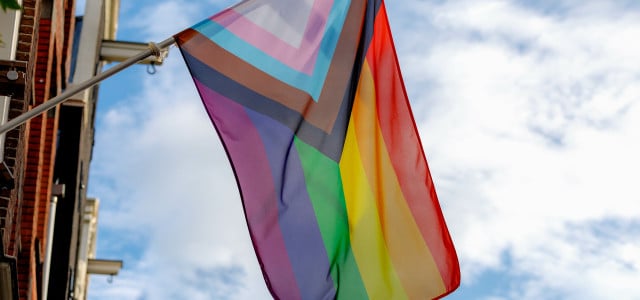
The Progress Pride flag adds more colors and symbols to the original rainbow flag. We explain what these are all about and why the flag stands for even more inclusion.
Since the beginning of its development, the Pride flag has stood for pride and empowerment of oppressed marginalized groups and represents queer communities. It is an important symbol against homophobia and sexism and should not be missing from any Christopher Street Day or Pride Parade. In its original form, the flag consists of six different colors arranged vertically.
The Progress Pride flag adds additional colors to the flag that specifically represent queer people of color and transgender people and give these groups more visibility. The flag is thus an important symbol for intersectionality. It thus shows that people’s identities can be affected by different mechanisms of oppression, for example by homophobia and racism at the same time.
Progress Pride Flage: The Story of the Rainbow Flag
The original six-color Pride flag was created in San Francisco in 1978. It was developed by the US activist and artist Gilbert Baker. According to him, the color red in the flag stands for life, orange for health, yellow for the sun, green for nature, blue for harmony and violet for the spirit. Actually, Baker had also planned a turquoise and a pink stripe for the flag. Turquoise should stand for art and pink for sexuality. However, these two colors were lost in the production process.
Baker developed the flag to celebrate Gay Freedom Day. With each subsequent year, the flag became better known in the queer scene and grew into an increasingly important symbol. In 1996, politicians hoisted the flag on public buildings in Berlin for the first time. Since 2015, the Pride flag can also be found in the Museum of Modern Art in New York.
In 2018, Daniel Qasar developed the Progress Pride flag. Qasar is from the USA and is a non-binary graphic designer. With the expansion of the flag, Qasar wants to acknowledge the progress that has already been made in the fight against oppressive mechanisms. On the other hand, he would like to call for more progress and inclusive solutions.
Progress Pride Flag: That’s what it stands for
Qasar added five more colors to the six original colors of the rainbow flag, arranged as triangle shaped arrows on the left part of the flag. The black and brown arrows stand for queer blacks and people of color and set an example in the fight against racism. Qasar took these ideas from the so-called Philly flag. In this variant of the Pride flag, the colors black and brown are printed as additional vertical stripes.
Qasar also added the colors white, light blue and pink. These are the colors of the trans flag. The trans flag was designed by activist and author Monica Helms. Pink and blue are the colors that we typically associate with male and female. So they stand for all cis people. These are people whose gender identity (gender) matches the gender determined at birth based on visible sexual characteristics. White represents anyone who changes their gender identity over time, does not identify as a gender, or is intersex.
There is also a new variant of the Progress Pride flag: Qasar’s design of the Pride flag is linked to the Intersex flag. The intersex flag is yellow with a purple colored circle in the middle. The idea of combining the flags came from Valentino Vecchietti, an intersex activist. The intersex symbol is primarily intended to draw attention to the fight of inter-persons for the right to physical integrity.
Intersex people are born with sex organs that cannot be clearly classified as male or female. In medicine, this often still counts as a “disorder” or “syndrome”. As a result, doctors sometimes operate on intersex children after birth or give them medication to adapt them to the prevailing binary gender system. The Progress Pride flag with the intersex symbol gives visibility to this oppression. Although it is still rare to find, it is already officially recognized in the queer community.
Where is the Progress Pride flag hanging?
This year, the Progress Pride flag with the additional symbols will be officially hanging in Berlin for the first time. This was ordered by the Senate Department for Justice, Diversity and Anti-Discrimination on the occasion of the day against homophobia on May 17th. With this, the politicians also want to draw attention to the situation of queer people who are currently fleeing the Russian war of aggression and whose escape is made more difficult by discrimination.
The Progress Pride flag has already been established in other cities around the world. You can find the hoisted flag in Sydney, London or New York, for example.
Read more on Techzle.com:
- Human rights organizations: These are the most important
- Gender Mainstreaming: What is behind the term?
- 6 film tips on the subject of equality and women’s rights
You might also be interested in these articles
-
Build self-confidence: Respect yourself in 8 steps
-
Positive Affirmations: This is how you help yourself to motivation and self-confidence
-
Pinkwashing: That’s behind it
-
Stretch hip flexors: 3 healthy exercises
-
Relationships: monogamous, polygamous or LAT? The future of partnership
-
Home remedies for herpes: This is how you get rid of the annoying blisters faster
-
The Sedona Method: finally let go of negative feelings
-
Eckart von Hirschhausen: “The climate crisis is also a health crisis”
-
Stiff neck: These home remedies help quickly and prevent